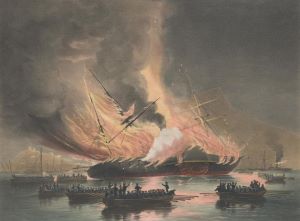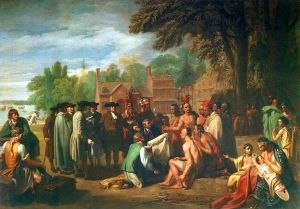“Illusions” at the American Museum
Last week we learned of Barnum’s plans for a brand-new attraction at the American Museum—a physioscope, which he described in a letter to Fordyce Hitchcock, manager of the museum. This week we’ll return to that same letter, written between October 25th and 31st, 1845, for there is yet more to explore about the exciting new “Dissolving Views” (a.k.a., magic lantern shows), as well as an older kind of popular attraction: large scale panoramas, the “immersive entertainment” of their day. For an introduction to these, see blog post, Manufactured Puffs and Dissolving Views, May 22, 2020.) Visual illusions in a variety of new and older formats were a reliable draw, and Barnum’s desire to offer changing, dynamic attractions was a good counterpoint to the traditional displays of natural history collections and artwork in his museum.
Earlier in 1845 while in London, Barnum had hired “Professor Swift” to move to New York and set up the museum’s lecture hall (theater) with various optical devices, including a camera obscura, and the two-lens projector to show dissolving views, images that gradually changed from one scene to another, captivating audiences with the appearance of magical transformation. This decision involved considerable expense on top of what Barnum had already spent purchasing glass slides and optical instruments, as he noted to one correspondent, “between 2000 & 3000 dollars.” After several months of preparation, Swift had everything ready to open to the public, and Barnum was pushing to get newspaper coverage, not only through ads, but also with “editorials” praising the American Museum’s shows. He was also trying to expand his audience beyond the city to attract tourists, and instructed Hitchcock to promote the dissolving views in “all other weekly papers, scientific, political, religious and neutral papers which go into the country.” As he wrote to C. D. Stuart on September 11th, “I think that those Dissolving Views ought to attract the attention & quarter dollar of every person who visits N.Y.”
By late summer the investment in dissolving views was showing promise; Barnum noted in his August 25th letter to his wife, Charity, that Hitchcock had reported “the dissolving views are drawing well, and the business is beginning to increase and will be excellent as soon as the weather is cooler.” But success would be short-lived if the material became stale so Barnum was anxious to keep his shows fresh by acquiring new views. Among a list of new items (including the Physioscope) that Barnum had bought and shipped off to America in mid-November were three dissolving views. Presumably these were purchased off the shelf, not specially ordered. They included a scene of Lyon, France, “with an effect to show the cathedral lighted,” a view of the American Steam Ship Missouri “with [the] effect to show her afterwards on fire,” and a scene of Canton, China, “with moving figures.”

Barnum was now aiming to have views of his own choosing made, and that would require hiring artists to paint the slides. Being in Europe provided better opportunities to have the views made there than in New York. Presumably Barnum felt that the results would be higher quality, and he had long-since planned to have a view of William Penn’s Treaty made. On a couple of occasions he remarked that he was still awaiting a picture of Penn’s Treaty from his friend Moses Kimball in Boston. Apparently it eventually arrived, for Barnum told Hitchcock that a “Mr. Welch who goes by this steamer will hand you a view of Penn’s Treaty for which I paid £5. Save it for Christmas & then crack it up with the other three views named below.”
Barnum was now relying on his manager to help get a bigger plan in motion. He advised Hitchcock,
I can have no American Views painted in London unless you send me copies—and if possible send the pictures same size that our views are, for in that case they can be put behind the glass and painted same size for half what they would cost if the painter must make them smaller or larger than the copy. If you can find some book printed containing pictures of the proper size—then you can go to the publisher of the book & get the pictures separate and send them to my friend Brettell [on] Rupert St. [London].
Barnum’s strategy for spending the least money possible on the copying of images mirrors the guidance he had given Professor Swift on September 29th:
. . .my dear fellow you must always keep improving our attractions and at the same time have a strict regard to economy. I want you to feel interested in my affairs and keep driving ahead in the same way that you know I am always driving business. By so doing you will advance both my interests and yours.
To be sure he knew what views were already in hand and the optimal size to order the new ones, Barnum directed Hitchcock to ask for Swift’s input.
I wish you to send me an exact list of every view we now have, and also tell me what views you want. Let Swift tell me what size is best for the lanterns—also whether pictures only 5 inches can be shown in them.

Barnum was also interested in acquiring different panoramas, or “dioramas” as he called them, for the museum. Telling Hitchcock, “I have given up trying to buy the diorama of Napoleons Funeral [in Paris],” he turned back to considering others that were stateside and which compared favorably to those he had just seen in London. He suggested to Hitchcock,
Perhaps you had better arrange with Harrington to buy or hire his moving dioramas. I believe that he is not now the owner of them and that they are in pawn in St. Louis. If you could buy them cheap (unless they are spoiled) it would be a good dodge for a change. They always please & are very pretty. There are none better in Europe. I went to see some in London—admission $1.00 (4 english shillings) and they were not half so fine as Harringtons. His sea view & Fairy Grotto beat all those in London.
The terms panorama and diorama seem to have been used at least somewhat interchangeably at the time, and as there were variations in the way the structures and presentation formats were configured, it can be a challenge to pin down exactly what is meant. Today a diorama is understood to be a static scene, with a realistic background painted to give the illusion of depth, and mounted in a curve. A three-dimensional foreground is created in front of the backdrop, with taxidermy animals, faux plant material, artifacts or objects to complete the illusion of an actual environment. Barnum uses the term diorama more broadly, and in this letter refers to “moving dioramas,” which may mean mechanical theaters. He went on to advise Hitchcock,
You might be arranging so as to bring them out in the winter or spring. In this country [France] managers engage attractions 6 months in advance & it is not a bad dodge for them [as] a person never gets caught without any attractions. Towards the last I only paid Harrington $15 per week for his Dioramas—and if we owned them I think we could always get them worked for that–& that they might be on our stage (at the back) without interfering with the other performances. Think of it.
That Barnum was quite familiar with Harrington’s work is evident in his letter. In fact, many New Yorkers would have known of these dioramas over a period of years. The context is clarified in entries in The Biographical Dictionary of Panoramists of the English-Speaking World (Ralph Hyde et al; unpublished; pdf. available online courtesy of the Bill Douglas Cinema Museum, University of Exeter, England). From these entries we learn that Henry Harrington (incorrectly spelled in one entry as Hanington) and his brother William were painters and showmen, and from 1835, they “presented ‘moving dioramas’ (in fact a mechanical theatre) at the City Saloon, opposite St. Paul’s Church on Broadway, New York.” Barnum’s Museum was also in that location, at the corner of Ann Street.
The entry for “Harrington, H.” describes him as a transparency painter, and notes that “with W. J. Harrington, between 1835-1837 [he] operated Marble Buildings (Dioramic Institute) on Broadway near Ann Street, presenting changing displays of dioramas.” There they exhibited the “Moving Panorama of Luna Discoveries and Diorama of the Deluge.” Perhaps the “sea view” Barnum mentioned to Hitchcock was the Diorama of the Deluge. The Harringtons also advertised their “Grand Moving Diorama” at the American Museum in December of 1835. This predates Barnum’s ownership, which commenced in late December 1841. (Prior to Barnum, the American Museum was operated by John Scudder, and then his descendants.) Clearly the venerable white marble museum building was no stranger to these grand visual illusions!
Wrapping up this deep dive into Barnum’s lengthy epistle, I’ll share an amusing bit that adds to the story of the fine porcelain and silver items Barnum had purchased at an estate auction in Paris. (See blog post, The Things Inside Case No. 8, Sept. 4, 2020) In a previous letter we learned that to his chagrin, Barnum owed the U.S. Customs an enormous sum ($600), levied on the luxury goods he had sent home. To rub salt into the wound, Barnum had learned that if only he and Charity had used the dishes while they were in Paris, the import duty would not have applied, or not at that rate. In the current letter Barnum wryly told Hitchcock,
My Box No 2 containing part of the porcelain dinner service is now here—it was left by mistake—I’ll send it one of these days & remember you have paid all the duty on it. I’ll smuggle enough if I live long, to get my $600 back which you paid duty.
One can only imagine Hitchcock’s initial reaction to this comment: he, who followed instructions precisely, and presumably the letter of the law as well!
Adrienne Saint-Pierre
Barnum Museum Curator

